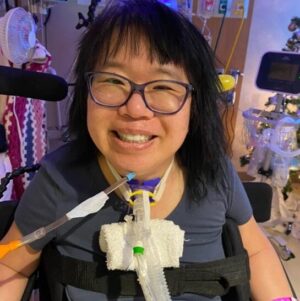Now in its 21st year, National Assisted Living Week celebrates the lives and achievements of individuals with disabilities, long-term illnesses and injuries. In observance of this year’s theme, “Keep Connected,” we are taking the time to recognize the many ways that technology can be used to increase opportunity and facilitate better care and communication.

This year’s theme is, “Keep Connected”
For as long as humans have walked the earth, we’ve sought to simplify and improve our lives with the use of technology.
From the earliest stone tools to the first personal computers, our inventions serve as a means to enhance our natural abilities, helping to strengthen our relationships with others and refine our understanding of the world.
A Smarter, More Connected World
Technology has granted us the power to not only improve but extend and save lives. Medical advances have given us greater power to diagnose and treat illnesses than ever before, and now “smart” assistive tech promises to revolutionize the way people suffering from debilitating illness or catastrophic injury live their lives as well.

The “tech revolution” includes personal trackers like this Fitbit Surge – via pcmag.com
The Internet has long been a means of virtual connection, allowing users to communicate with one another whether across the street or across the world. Now, the Internet is increasingly used to connect us to the world itself. Smart devices – Internet-enabled objects powered by ever-smaller chips and sensors – have begun a revolution in which everything from watches to WiFi thermostats are able to share data with us and with each other. While the obvious appeal is often novelty or convenience, this shift also represents a powerful new way for people with a disability to live richer, more connected and more independent lives.

A “smart assistant” can help you control multiple features in your home – via vivint.com
Staying Connected
Each year, National Assisted Living Week encourages us to celebrate those who require assisted living and their caregivers, as well as to recognize the unique challenges they face. This year’s theme reminds us how vitally important it is for individuals with chronic diseases or disabilities to stay connected to friends, family and the world around them. Feelings of isolation and helplessness are common, and disability can erect seemingly insurmountable physical and social barriers. Fortunately, that may not be the case for much longer. Technology provides solutions that may allow disabled individuals to live more independent and interconnected lives, leading to improved quality of life and overall well-being.

Kirby repurposed existing tech to make life easier for his wife, our client Suria Nordin
Empowerment through Technology
The steady march of technology continues to remove obstacles that once isolated individuals with disabilities. Where the ability to operate a mouse and keyboard was once a necessity, voice recognition technology now provides easier access to phones, computers and other devices. Artificial intelligence, though still in its early stages, has already given us personal assistants that can handle many routine tasks that were once a source of struggle for many people. Home automation grants the power to remotely control and automatically adjust the local environment, from thermostat settings to interior lighting to door locks and other security features. Wearable technology opens new avenues not only for staying connected but for doctors and health workers to collect important information that may allow them to provide a higher level of personalized care.

Mikki Marshall controls her home environment through technology for greater independence – via control4.com
Turning Disability into Ability
“Smart” technologies like home automation, service robotics and the Internet of Things are still in their infancy, but their potential impact is already being felt. The future has never looked brighter for individuals living with chronic illnesses, catastrophic injuries and other disabilities, as these technologies are poised to revolutionize the way they interact with the world, connect with friends and family and manage their health. Providing assistance that allows for more active endeavors and ability to enjoy many of the freedoms others take for granted, technology can provide tremendous support for people with disabilities and those who care for them.

Robot assistants could revolutionize home health care and senior care – via spectrum.ieee.org
Mobile technologies may also lead to improved health care and lower medical costs by providing more high-quality data, assisting in the diagnosis and management of health conditions, helping to prevent accidents and keeping patients actively involved and invested in their care.

Integrated assistive tech can eliminate anxieties and open new possibilities
Technology has always had a central role in shaping both the present and the future. As smart products and mobile computing devices become more sophisticated, they will continue transforming the ways in which we interact with both our surroundings and one another. The many obstacles that people with disabilities and debilitating illnesses face won’t disappear overnight, but by keeping – and staying – “connected,” the world is a more welcoming and accessible place for everyone.
This guest post was written and submitted by Beth K, a freelance writer specializing in home automation and technology topics. How will you celebrate National Assisted Living Week?
Now in its 21st year, National Assisted Living Week celebrates the lives and achievements of individuals with disabilities, long-term illnesses and injuries. In observance of this year’s theme, “Keep Connected,” we are taking the time to recognize the many ways that technology can be used to increase opportunity and facilitate better care and communication.

For as long as humans have walked the earth, we’ve sought to simplify and improve our lives with the use of technology.
From the earliest stone tools to the first personal computers, our inventions serve as a means to enhance our natural abilities, helping to strengthen our relationships with others and refine our understanding of the world.
A Smarter, More Connected World
Technology has granted us the power to not only improve but extend and save lives. Medical advances have given us greater power to diagnose and treat illnesses than ever before, and now “smart” assistive tech promises to revolutionize the way people suffering from debilitating illness or catastrophic injury live their lives as well.

The Internet has long been a means of virtual connection, allowing users to communicate with one another whether across the street or across the world. Now, the Internet is increasingly used to connect us to the world itself. Smart devices – Internet-enabled objects powered by ever-smaller chips and sensors – have begun a revolution in which everything from watches to WiFi thermostats are able to share data with us and with each other. While the obvious appeal is often novelty or convenience, this shift also represents a powerful new way for people with a disability to live richer, more connected and more independent lives.

Staying Connected
Each year, National Assisted Living Week encourages us to celebrate those who require assisted living and their caregivers, as well as to recognize the unique challenges they face. This year’s theme reminds us how vitally important it is for individuals with chronic diseases or disabilities to stay connected to friends, family and the world around them. Feelings of isolation and helplessness are common, and disability can erect seemingly insurmountable physical and social barriers. Fortunately, that may not be the case for much longer. Technology provides solutions that may allow disabled individuals to live more independent and interconnected lives, leading to improved quality of life and overall well-being.

Empowerment through Technology
The steady march of technology continues to remove obstacles that once isolated individuals with disabilities. Where the ability to operate a mouse and keyboard was once a necessity, voice recognition technology now provides easier access to phones, computers and other devices. Artificial intelligence, though still in its early stages, has already given us personal assistants that can handle many routine tasks that were once a source of struggle for many people. Home automation grants the power to remotely control and automatically adjust the local environment, from thermostat settings to interior lighting to door locks and other security features. Wearable technology opens new avenues not only for staying connected but for doctors and health workers to collect important information that may allow them to provide a higher level of personalized care.

Turning Disability into Ability
“Smart” technologies like home automation, service robotics and the Internet of Things are still in their infancy, but their potential impact is already being felt. The future has never looked brighter for individuals living with chronic illnesses, catastrophic injuries and other disabilities, as these technologies are poised to revolutionize the way they interact with the world, connect with friends and family and manage their health. Providing assistance that allows for more active endeavors and ability to enjoy many of the freedoms others take for granted, technology can provide tremendous support for people with disabilities and those who care for them.

Mobile technologies may also lead to improved health care and lower medical costs by providing more high-quality data, assisting in the diagnosis and management of health conditions, helping to prevent accidents and keeping patients actively involved and invested in their care.

Technology has always had a central role in shaping both the present and the future. As smart products and mobile computing devices become more sophisticated, they will continue transforming the ways in which we interact with both our surroundings and one another. The many obstacles that people with disabilities and debilitating illnesses face won’t disappear overnight, but by keeping – and staying – “connected,” the world is a more welcoming and accessible place for everyone.
This guest post was written and submitted by Beth K, a freelance writer specializing in home automation and technology topics. How will you celebrate National Assisted Living Week?











